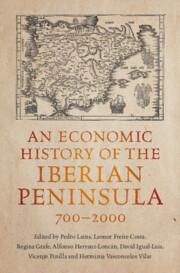Book contents
- An Economic History of the Iberian Peninsula, 700–2000
- An Economic History of the Iberian Peninsula, 700–2000
- Copyright page
- Contents
- Figures
- Tables
- Contributors
- Preface: By Way of Presentation
- Introduction
- Part I The Making of Iberia, 700–1500
- Section I The Early Middle Ages, 700–1200
- Section II The Medieval Economy, 1000–1500
- 2 Production, 1000–1500
- 3 Population, 1000–1500
- 4 The Polity, 1000–1500
- 5 Money, Credit and Banking, 1000–1500
- 6 Technology, 1000–1500
- 7 Living Standards, 1000–1500
- 8 International Trade and Commerce, 1000–1500
- 9 The Iberian Economy in Global Perspective, 700–1500
- Part II Globalization and Enlightenment, 1500–1800
- Part III Industrialization and Catching Up, 1800–2000
- References
- Index
5 - Money, Credit and Banking, 1000–1500
from Section II - The Medieval Economy, 1000–1500
Published online by Cambridge University Press: 22 February 2024
- An Economic History of the Iberian Peninsula, 700–2000
- An Economic History of the Iberian Peninsula, 700–2000
- Copyright page
- Contents
- Figures
- Tables
- Contributors
- Preface: By Way of Presentation
- Introduction
- Part I The Making of Iberia, 700–1500
- Section I The Early Middle Ages, 700–1200
- Section II The Medieval Economy, 1000–1500
- 2 Production, 1000–1500
- 3 Population, 1000–1500
- 4 The Polity, 1000–1500
- 5 Money, Credit and Banking, 1000–1500
- 6 Technology, 1000–1500
- 7 Living Standards, 1000–1500
- 8 International Trade and Commerce, 1000–1500
- 9 The Iberian Economy in Global Perspective, 700–1500
- Part II Globalization and Enlightenment, 1500–1800
- Part III Industrialization and Catching Up, 1800–2000
- References
- Index
Summary
This chapter describes the key changes in terms of money, credit and banking in the 1000 to 1500 period within the various kingdoms. It highlights how after a period of late monetization, each Christian kingdom transitioned to centralized models that were well-articulated with their European counterparts while keeping important distinctive traits. Nevertheless, the demand for means of payment on behalf of kings, merchants and other agents stimulated the development of credit. The need for credit spanned the entire Peninsula and the urban/rural divide. Thus, all countries saw the emergence of lively credit markets for (mostly private) borrowers, buttressed by functioning courts and regulations. These markets involved both specialists and non-specialists, but it was only in the Crown of Aragon where financial agents transitioned to institutionalized banks.
- Type
- Chapter
- Information
- An Economic History of the Iberian Peninsula, 700–2000 , pp. 130 - 157Publisher: Cambridge University PressPrint publication year: 2024

